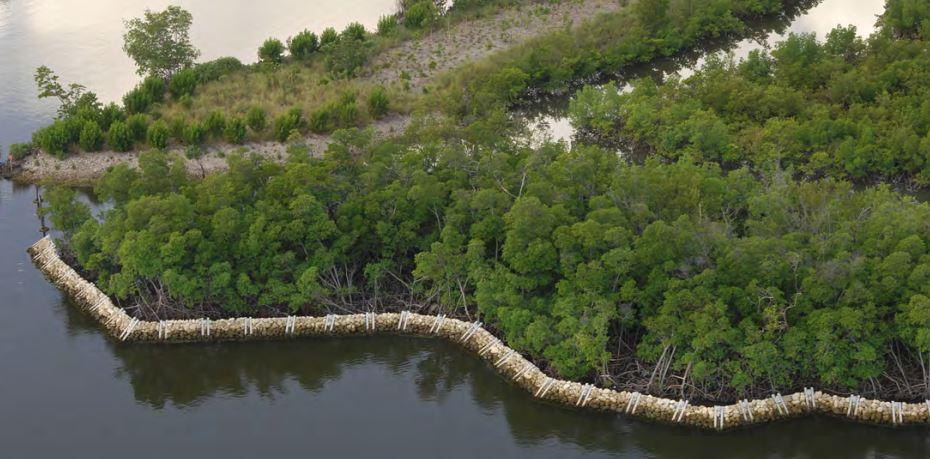Coral Reefs
Coral reefs are underwater structures made of calcium carbonate and found in tropical waters. They are built over time by stony or reef building corals, as well as other organisms, that secrete calcium carbonate to build the physical structure of the reef. While relatively uncommon – coral reefs occupy only about 1% of the global sea surface – they support about 25 percent of the oceans biodiversity and are vitally important as a source of food, shelter, medicine, and cultural and aesthetic value to coastal communities.
Coral reefs are generally broken into three categories based upon their proximity to land and their general shape – barrier, fringing, and atolls. Of those main types, only barrier reefs are found in southern Florida and Hawaii, the two areas in the United States where coral reefs are present.
Reef building corals rely on a symbiotic relationship with zooxanthellae algae which produce carbohydrates from sunlight that the corals then feed on. At night, or when photosynthesis isn’t sufficient, corals are also able to feed on plankton from the water column.
Hazard Mitigation
Coral reefs effectively serve as a natural breakwater, protecting coasts from erosion and flooding by absorbing wave energy as waves come in contact with and move across the physical structure of the reef. Coral reefs can reduce as much as 97% of total wave energy, greatly limiting the impacts to the protected land and calming the waters on the backside of the reef, thus allowing for the trapping and accretion of sand. Healthy reefs can provide coastal protection, even during storm events with strong wave conditions.
Coral reefs generate massive amounts of carbonate as they grow and are generally expected to be able to keep pace with sea level, if they remain healthy. However, there is growing concern that coral mortality is increasing while coral recruitment, particularly for reef-building corals, is decreasing and that reefs worldwide may not be able to compensate for climate related impacts in the near future.

Threats
Corals are a particularly sensitive species that can thrive under optimum circumstances but are particularly sensitive to threats and impacts. There are three principal threats to coral reefs – climate change, land based pollution, and damage from marine activities (fishing, boating, etc.). Reef building corals are particularly sensitive to water temperature, preferring to live within a very small temperature range. When water temperatures get too high, a “bleaching” event – where corals expel the zooxanthellae algae from their living tissues – occurs, potentially resulting in the death of the coral or, at a minimum, greatly weakening the coral and increasing the potential for disease and degradation. In addition to increased water temperatures, ocean waters are becoming more acidic, reducing the rate that corals can actually build reefs and weakening the calcium carbonate that they produce.
In addition to water temperature, corals are also sensitive to water quality. Land based pollution, anything from agricultural run-off to industrial or sewage waste to excessive sediment in the water, can significantly impact coral growth. In U.S. waters there are a number of coral reefs that have been impacted due to changes in drainage on land and the increased runoff associated with coastal development and urbanization.
Corals also suffer from direct impacts, such as boat strikes, fishing practices and contact with divers. While none of these impacts on their own may be of great concern, these small injuries can add up quickly and degrade the overall health and resilience of the reef. As such, efforts should be made to minimize these impacts and threats, as preventing degradation of reefs that protect shorelines is a much more cost-effective approach than working to restore them once they’ve been lost.
Co-Benefits
Healthy coral reefs play a vital role in providing shelter, habitat, and food for numerous species in the nearshore environment. Some estimates have found that nearly 25% of all marine species rely on coral reefs for some aspect of their life cycle.
Of the species that rely on reefs, many are recreationally or commercially important. According to NOAA, the commercial value of coral reef based fisheries is more than $100 M annually across the United States. Coral reef based tourism in the Florida Keys has been estimated to provide more than $1 B of economic activity annually.
Additional Resources
NOAA has a Coral Reef Conservation Program and website that provides a wide array of information on reef health, management, conservation funding, and other useful guidance.
The Reef Resilience Network has developed guidance to help managers address the impacts of climate change on coral reefs. Trainings, webinars, tools, and access to other professionals are all available on the website.
Scientists from the Nature Conservancy, USGS, Stanford, and other academic institutions collaborated on a study looking at the effectiveness of coral reefs at reducing coastal hazards such as storm surge.

